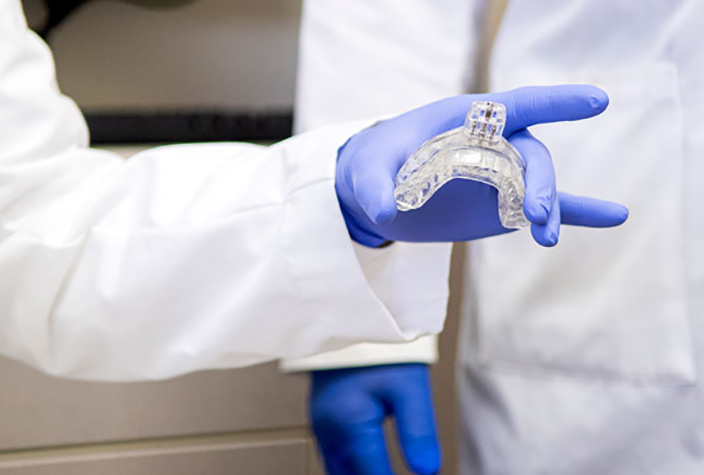Sleep apnea: Plastic devices could displace CPAP for severe cases

The fallout from sleep apnea was severely affecting Jim Elliott’s life, but 10 years on a bulky CPAP breathing device wasn’t the answer. Instead, a simple plastic dental appliance has changed his life.
Elliott was one of 56 individuals diagnosed with moderate to severe sleep apnea who opted to participate in a Texas A&M University College of Dentistry Sleep Research Program study called “Randomized Trial of 2 Self-Titrated Oral Appliances for Airway Management.” The investigation compared two widely used oral appliance designs and concluded that their use dramatically improved patients’ breathing during sleep, as reflected in the respiratory event index. Results were published in the Journal of Dental Research in 2020.
Funded in part with $480,000 from the Baylor Oral Health Foundation and $75,000 of in-kind donations, the study compared midline traction versus bilateral thrust oral appliances. Such dental-inspired research to alleviate sleep apnea is among the latest in several ongoing clinical studies focused on using state-of-the-art oral appliances to manage the airway and, in turn, improve sleep and overall health.
“In that study we found they were both quite effective in treating their sleep apnea,” said Emet Schneiderman, director of the Sleep Research Program and professor in biomedical sciences at the College of Dentistry.
“The aspect of the study that was probably the most important was that we looked at people who had moderate and severe obstructive sleep apnea. The dogma forever has been that oral appliances are good for mild and moderate, but we found they are even more effective for people with severe sleep apnea,” Schneiderman said.
The CPAP, or Continuous Positive Airway Pressure machine, is considered successful if patients lower their score to below five on the apnea hypopnea index (AHI). AHI measures the number of apneas and hypopneas recorded per hour, which is when someone tries to breathe but their airway is fully or partially blocked. Thirty and above is considered severe, 29 to 15 is moderate and 14 to five per hour is mild.
The respiratory event index is an alternate measure that is readily acquired using a compact sleep-monitoring system in a person’s home—a feature of the Sleep Research Program’s clinical studies that makes it convenient for patients to participate. Prior to this type of system, sleep could only be studied in an overnight sleep laboratory, often a foreboding and expensive experience.
The ultimate goal is to reach fewer than five episodes each hour, which a CPAP is able to accomplish, Schneiderman says. Getting to that level using an oral appliance is a little harder. Yet current approaches are getting closer.
“A lot of us like to sleep on our backs. As we get older, the muscles of the throat become lax, and we also tend to put on weight. Those factors tend to conspire to close the airway at night,” Schneiderman said. “The tongue falls backward against the soft palate and back of the throat. If some air is allowed to pass through, it vibrates, and that’s snoring. If it’s completely closed, it’s apnea, where you quit breathing altogether.”
The oral apparatus that the Sleep Research Program is testing now—which resembles upper-and-lower night guards used for patients who grind their teeth—can be molded and fitted by qualified dentists chairside (next to the dental chair during treatment). The thermoplastic is heated until it’s almost a gel form, then placed in the patients’ mouths for a perfect fit.
“You fit it to the teeth, and it has an adjustment screw on it,” Schneiderman said. “By turning that, it brings the lower jaw forward. That has to be done very gradually and carefully and monitored so the jaw joint is not injured. We have to be very vigilant to preserve proper oral function and health. That’s a very good reason for a properly trained dentist to always be involved.”

